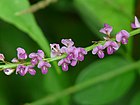Note: This is a project under development. The articles on this wiki are just being initiated and broadly incomplete. You can Help creating new pages.
Desmodium gangeticum - Shaalaparni, Murelehonne
Abrus precatorius is a severely invasive plant in warm temperate to tropical regions. It had been widely introduced by humans and the brightly coloured and hard-shelled seeds had been spread by birds.
Uses
Parts Used
Chemical Composition
It contains Flavonoids, Genistein, Hydroxygenistein, Prenyl, Trimethoxy, Methylenedioxy and Flavone[1]
Common names
| Language | Common name |
|---|---|
| Kannada | Murelehonne, Muruluboane |
| Hindi | Chirpat, Chuppa, Salpalnu |
| Malayalam | Orila, Pullati |
| Tamil | Pulladi, Pullati, Sirupulladi |
| Telugu | Getanaramu, Gitanaram |
| Marathi | NA |
| Gujarathi | NA |
| Punjabi | NA |
| Kashmiri | NA |
| Sanskrit | Shalaparni, Shalidala, Shaliparni |
| English | Sal leaved desmodium |
Properties
Reference: Dravya - Substance, Rasa - Taste, Guna - Qualities, Veerya - Potency, Vipaka - Post-digesion effect, Karma - Pharmacological activity, Prabhava - Therepeutics.
Dravya
Rasa
Guna
Veerya
Vipaka
Karma
Prabhava
Habit
Identification
Leaf
| Kind | Shape | Feature |
|---|---|---|
| Unifoliate | ovate to ovatelanceolate | Membranous, and mottled with grey patches |
Flower
| Type | Size | Color and composition | Stamen | More information |
|---|---|---|---|---|
| Inflorescence | 2-4cm long | Purple, lilac to white in colour | Flowering and occur twice a year | Inflorescence is elongated, lax, terminal or axillary raceme |
Fruit
| Type | Size | Mass | Appearance | Seeds | More information |
|---|---|---|---|---|---|
| Pod | Moniliform (beaded), six to eight jointed | Seeds upto 5 | Flowering and fruiting occur twice a year |
Other features
List of Ayurvedic medicine in which the herb is used
Where to get the saplings
Mode of Propagation
How to plant/cultivate
The crop can be raised easily through seeds, which germinate without any pretreatment. Seeds are collected during July–August and October– November. The collected seeds retain their viability for three years under normal storage conditions. [4]
Commonly seen growing in areas
Photo Gallery
References
- ↑ Chemical composition
- ↑ Kappatagudda - A Repertoire of Medicianal Plants of Gadag by Yashpal Kshirasagar and Sonal Vrishni, Page No. 162
- ↑ Ayurvedic preparations
- ↑ Cultivation detail
External Links
- Ayurvedic Herbs known to be helpful to treat Blisters in mouths
- Ayurvedic Herbs known to be helpful to treat Mouth sores
- Ayurvedic Herbs known to be helpful to treat Bleeding piles
- Herbs with Seeds used in medicine
- Herbs with Stem used in medicine
- Herbs with Leaves used in medicine
- Herbs with Roots used in medicine
- Herbs with common name in Kannada
- Herbs with common name in Hindi
- Herbs with common name in Malayalam
- Herbs with common name in Tamil
- Herbs with common name in Telugu
- Herbs with common name in Sanskrit
- Herbs with common name in English
- Habit - Shrub
- Index of Plants which can be propagated by Seeds
- Herbs that are commonly seen in the region of Tropical area
- Herbs that are commonly seen in the region of Caribbean Islands
- Herbs that are commonly seen in the region of Subtropical area
- Herbs that are commonly seen in the region of Pinelands
- Herbs that are commonly seen in the region of Hammocks
- Herbs
- Fabaceae







